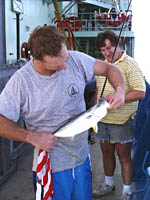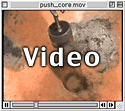
TODAY'S WEATHER
Cloudy
60°F
(15.6°C)
Latitude:
27deg 0’ N
Longitude: 111deg 24’ W
Wind Direction: W
Wind Speed: 7 Knots
Sea State: 1
Sea Temperature: 62°F (16.7°C)
Barometric Pressure: 1016.6 MB
Visibility: 20 Nautical Miles
COMMENTS
- SAW A LARGE WHALE FEEDING AROUND SHIP YESTERDAY MORNING FOR 2 HOURS
- A POD OF SPERM WHALES CROSSED BOW AROUND SUPPER
TIME LAST EVENING
WHAT'S TO EAT TODAY?
BREAKFAST
Scrambled Eggs and Sausage
Waffles
Bacon, Swiss Cheese Fritatta
Irish Oatmeal
Fruit
LUNCH
Oyster Stew
Roast Beef and Swiss Sandwiches on Whole Wheat
Shrimp and Veggie Stir Fry
Broccoli and Cheddar Quiche
Macaroni and Cheese
Frozen Milky-Way and Snickers Bars
DINNER
Filet Mignon with Grilled Portabella Mushrooms and Onions
Mahi-Mahi with Raspberry Sweet & Sour Sauce
Baked Potatoes
Zucchini Saute with Garlic and Olive Oil
Roasted Rutabagas
Peach Crisp ala Mode (Vanilla Ice Cream)
Daily Update: Dive
3519
January 16, 2000
By Dr. Dan Fornari and Dr. Susan Humphris
Sunday is usually a day when people relax and spend time with family or friends.
Not out here. At sea, Sunday is like any other day. Alvin makes another dive, while everybody
else works away. But it was a day filled with success stories.
The microbiological work is producing results! Scientists learn about the microbes
that live in and around deep-sea hydrothermal vents by growing (culturing) them
in the laboratory. To do so, they must duplicate the temperature and chemical
conditions of the microbes natural environment.
The scientists combine various chemicals that the microorganisms need to grow
and survive into a mixture (medium).
They then pour these mediums into specialized containers that have been sterilized
to keep out unwanted organisms. Finally, they place the sulfide samples that
they had collected on Dives 3517 and 3518 into these mediums.
There are now microorganisms growing in some of the test tubes!
It turns out that each of the organisms they are culturing requires carbon dioxide
to grow. However, the other chemicals that they require differ from organism to organism.
Some require hydrogen and iron. Others need sulfur and hydrogen. Still others use hydrogen
and oxygen.
The microbiologists are especially excited because they think that some of the microorganisms
they are culturing may be new to science! They won't know for sure, however, until they have
a chance to examine the microbes' DNA back on shore and compare these "fingerprints" to those
of other microbes.
Sunday was not all work, however. That afternoon Pat Hickey spotted a school of young yellow-fin
tuna swimming around the stern. Several people tried to catch them, but only Pat succeeded.
The tuna he caught was only 18 inches long, so he let it go.
The excitement continued that evening when the submarine returned. The scientists
had brought back the first clams of the cruise! The clams’ insides are
red because their tissue contains blood. These clams are of particular interest
because they live buried beneath the sediment. Here at Guaymas, the thick sediment
layer covering the seafloor contains hydrocarbons. It's as if the clams are
living inside an oil barrel! Yet the clams appear to be healthy. Tim Shank, one
of the scientists on board, is interested in learning how the clams have adapted
to living in this toxic environment. He will be analyzing their DNA for clues.
The other success story was the sediment coring! Recall that during earlier dives, the scientists
were unable to bring up cores that had all of the sediment layers intact. One problem was that when
the cores reached the surface, hydrocarbon gas bubbled out, mixing up the sediment layers.
This time, George Luther and his group decided to use a smaller diameter corer. During the Alvin dive,
observers Tim Rozan and Melissa Kendall collected cores of dark brown mud instead of the hydrocarbon-rich
black mud. They are now happily measuring the iron and hydrogen sulfide concentrations in the cores.
They will collect more cores tomorrow on Dive 3520.
Dive Summary
On Bottom: 0908 hrs
Off Bottom: 1542 hrs
Maximum Depth: 2011 m
Dive 3519, piloted by BLee Williams, took Tim Rozan and Melissa Kendall on their first Alvin dive of the cruise.
This time they took a scoop net to try to dig clams out of the mud. They also took some special sampling devices called
gas-tight bottles. These bottles are designed to collect hydrothermal fluids without losing the gases that are dissolved
in the fluid. They visited three sites and collected sulfide samples, clams, and sediment cores. They also measured water
temperatures and collected "Sipper" samples. They collected four gas tight samples from two different vents. Two of the
samples contained hot fluid that had pooled underneath a ledge or flange. The other two samples contained fluid that was
venting from a chimney.
|



